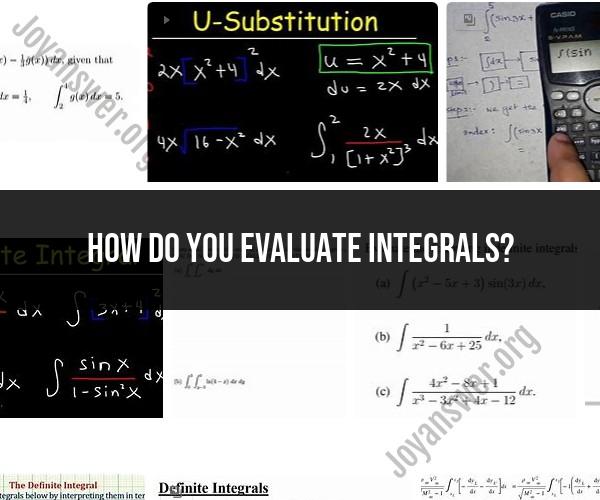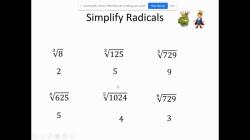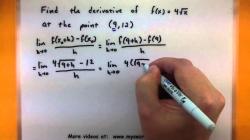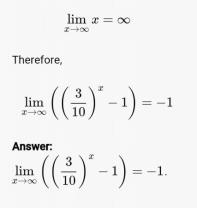How do you evaluate integrals?
Evaluating integrals is a fundamental topic in calculus, and there are various techniques and methods available for finding the antiderivative of a function. The choice of method often depends on the form and complexity of the integral. Here are some common techniques and methods for evaluating integrals:
Direct Integration (Power Rule):
- If the integrand (the function being integrated) is a polynomial, you can use the power rule. For example, to integrate x^n, where n is a constant (except when n = -1), add 1 to the exponent and divide by the new exponent: ∫x^n dx = (x^(n+1))/(n+1) + C.
Trigonometric Substitution:
- When the integrand contains trigonometric functions, it may be helpful to use trigonometric identities or trigonometric substitution to simplify the integral. Common substitutions include u-substitution and trigonometric identities like the Pythagorean identities.
Integration by Parts:
- Integration by parts is a technique used for integrating the product of two functions. It's based on the formula ∫u dv = uv - ∫v du, where u and dv are differentiable functions. You choose which function to differentiate (u) and which to integrate (dv).
Partial Fraction Decomposition:
- If the integrand is a rational function (a fraction of polynomials), you can use partial fraction decomposition to break it down into simpler fractions. This technique is especially useful for integrating complex rational functions.
Trigonometric Integrals:
- For integrals involving trigonometric functions like sine, cosine, secant, and tangent, you can use trigonometric identities or specific integration rules for these functions.
Substitution (u-substitution):
- Substitution involves making a change of variables by setting u equal to part of the integrand. This can simplify the integral and make it easier to evaluate. It's especially useful when you have a composite function inside the integral.
Definite Integrals:
- To evaluate a definite integral, find the antiderivative as usual and then subtract the values at the upper and lower limits of integration. This gives you the net area between the curve and the x-axis over the specified interval.
Numerical Integration:
- In cases where you cannot find a symbolic antiderivative, numerical methods like the trapezoidal rule, Simpson's rule, or numerical integration software can be used to approximate the integral.
Tables and Computer Software:
- Many integrals can be evaluated using tables of integrals or computer algebra systems like Mathematica, MATLAB, or symbolic math software like SymPy in Python.
Special Functions:
- Some integrals involve special functions like the gamma function, beta function, or elliptic integrals. These functions have specific properties and identities that can be used to evaluate integrals involving them.
The choice of method depends on the specific integral you are trying to evaluate. It often requires creativity and practice to recognize which technique is most appropriate for a given integral. Additionally, complex integrals may require a combination of multiple techniques to solve effectively.
Demystifying Integral Evaluation: A Beginner's Guide
Integrals are a fundamental concept in calculus. They are used to calculate the area under a curve, the volume of a solid, and the length of a curve.
To evaluate an integral, you need to find the antiderivative of the function. The antiderivative of a function is another function whose derivative is the original function.
There are a number of different ways to evaluate integrals. Some of the most common methods include:
- The power rule: The power rule states that the antiderivative of x^n is (x^(n+1))/(n+1), where n is any real number except for -1.
- Integration by parts: Integration by parts is a method used to evaluate integrals of the form ∫ u(x) v′(x) dx. It works by breaking the integral into two parts: ∫ u(x) dx and ∫ v′(x) dx. These two parts are then integrated separately and then multiplied together.
- U-substitution: U-substitution is a method used to evaluate integrals that can be rewritten in the form ∫ f(u(x)) u′(x) dx. It works by substituting a new variable, u, into the integral. The integral is then rewritten in terms of u and integrated.
The Art of Finding Areas: Basics of Evaluating Integrals
One of the most common applications of integrals is to calculate the area under a curve. To do this, you can use the following formula:
∫ f(x) dx = A
where A is the area under the curve f(x) between the limits of integration a and b.
To evaluate this integral, you need to find the antiderivative of f(x). Once you have the antiderivative, you can plug in the limits of integration and subtract the results.
For example, to calculate the area under the curve y = x^2 between the limits of integration 0 and 1, you would use the following steps:
- Find the antiderivative of f(x) = x^2. The antiderivative of x^2 is (x^3)/3.
- Plug in the limits of integration and subtract the results:
∫ x^2 dx = (x^3)/3
∫_0^1 x^2 dx = ((1)^3)/3 - ((0)^3)/3 = 1/3
Therefore, the area under the curve y = x^2 between the limits of integration 0 and 1 is 1/3.
From Limits to Integrals: Understanding the Calculus of Integration
Integrals are closely related to limits. In fact, the fundamental theorem of calculus states that the definite integral of a function is equal to the limit of its Riemann sums as the number of terms in the sum approaches infinity.
Riemann sums are a way of approximating the area under a curve by dividing the area into a number of thin rectangles. The sum of the areas of the rectangles is then an approximation of the total area under the curve.
The fundamental theorem of calculus states that the definite integral of a function is equal to the limit of its Riemann sums as the number of terms in the sum approaches infinity. This means that integrals can be used to calculate the area under a curve by taking an infinite number of infinitely thin rectangles.
The calculus of integration is a powerful tool that can be used to solve a variety of problems. By understanding the basics of integral evaluation, you can learn to calculate the area under a curve, the volume of a solid, and the length of a curve.













